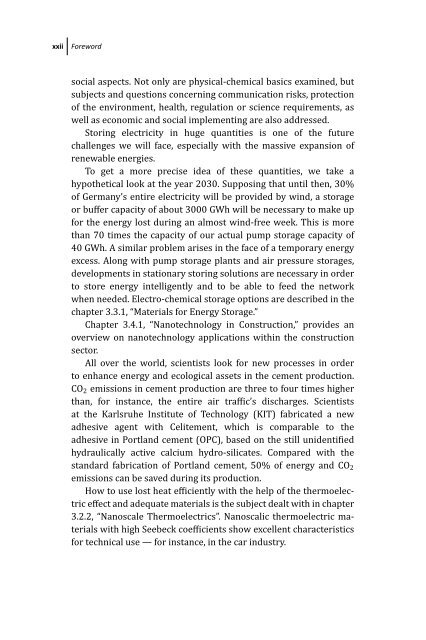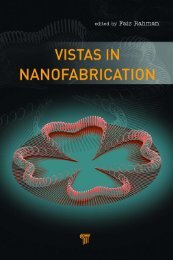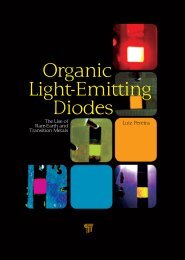Download PDF - Pan Stanford Publishing
Download PDF - Pan Stanford Publishing
Download PDF - Pan Stanford Publishing
You also want an ePaper? Increase the reach of your titles
YUMPU automatically turns print PDFs into web optimized ePapers that Google loves.
xxii<br />
Foreword<br />
social aspects. Not only are physical-chemical basics examined, but<br />
subjects and questions concerning communication risks, protection<br />
of the environment, health, regulation or science requirements, as<br />
well as economic and social implementing are also addressed.<br />
Storing electricity in huge quantities is one of the future<br />
challenges we will face, especially with the massive expansion of<br />
renewable energies.<br />
To get a more precise idea of these quantities, we take a<br />
hypothetical look at the year 2030. Supposing that until then, 30%<br />
of Germany’s entire electricity will be provided by wind, a storage<br />
or buffer capacity of about 3000 GWh will be necessary to make up<br />
for the energy lost during an almost wind-free week. This is more<br />
than 70 times the capacity of our actual pump storage capacity of<br />
40 GWh. A similar problem arises in the face of a temporary energy<br />
excess. Along with pump storage plants and air pressure storages,<br />
developments in stationary storing solutions are necessary in order<br />
to store energy intelligently and to be able to feed the network<br />
when needed. Electro-chemical storage options are described in the<br />
chapter 3.3.1, “Materials for Energy Storage.”<br />
Chapter 3.4.1, “Nanotechnology in Construction,” provides an<br />
overview on nanotechnology applications within the construction<br />
sector.<br />
All over the world, scientists look for new processes in order<br />
to enhance energy and ecological assets in the cement production.<br />
CO 2 emissions in cement production are three to four times higher<br />
than, for instance, the entire air traffic’s discharges. Scientists<br />
at the Karlsruhe Institute of Technology (KIT) fabricated a new<br />
adhesive agent with Celitement, which is comparable to the<br />
adhesive in Portland cement (OPC), based on the still unidentified<br />
hydraulically active calcium hydro-silicates. Compared with the<br />
standard fabrication of Portland cement, 50% of energy and CO 2<br />
emissions can be saved during its production.<br />
How to use lost heat efficiently with the help of the thermoelectric<br />
effect and adequate materials is the subject dealt with in chapter<br />
3.2.2, “Nanoscale Thermoelectrics”. Nanoscalic thermoelectric materials<br />
with high Seebeck coefficients show excellent characteristics<br />
for technical use — for instance, in the car industry.

















